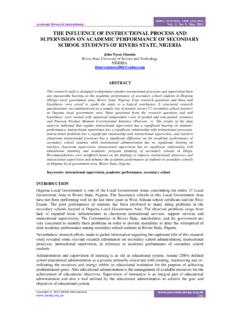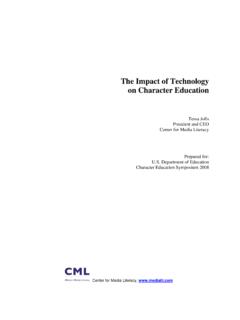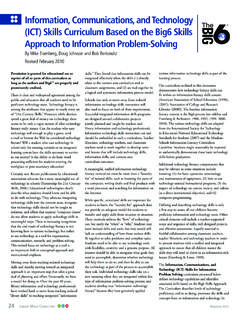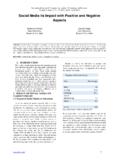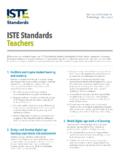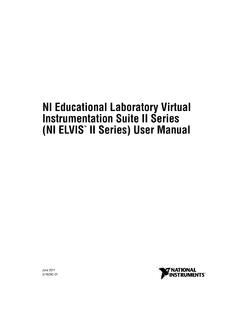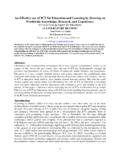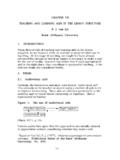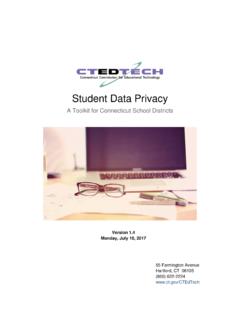Transcription of USING EDUCATIONAL MEDIA AND TECHNOLOGY …
1 ISSN-L: 2223-9553, ISSN: 2223-9944 Vol. 4 No. 1 January 2013 Academic Research International 292 Copyright 2013 SAVAP International USING EDUCATIONAL MEDIA AND TECHNOLOGY2 IN TEACHING AND LEARNING PROCESSES: A CASE OF TRAINEE TEACHERS AT AFRICA UNIVERSITY Victoria Oyedele1, John Rwambiwa2, Attwell Mamvuto3 1&2 Africa University, 3 University of Zimbabwe, ZIMBABWE. ABSTRACT This paper is an outcome of an analysis of secondary school trainee teachers views and their use of EDUCATIONAL MEDIA and TECHNOLOGY (EMT) during teaching practice. It also sought their trainers views on how the students used EMT. Sixty undergraduate education students from Africa University who had undergone a Teaching Practice3 (Practicum) programme, in secondary schools, and their fifteen lecturers were involved in this study.
2 A mixed methodologies approach was used, hence questionnaires, interviews and observations were used to collect data. Responses were analysed USING frequency counts for the quantitative data while opinionated views were qualitatively analysed. The results indicate that while trainees appreciated the role of EMT in teaching and learning, the majority of the trainees did not however, use EMT during their teaching, and that there were inadequate and functioning EMT facilities in the practicing schools. Resources were limited for both teachers and pupils, with the exception of printed materials and some obsolete equipment that lacked compatibility with modern technologies. Text books, where available, were mostly foreign and hence not suitable for Zimbabwean conditions.
3 Suggestions on how to promote the utilisation of EMT by teachers are made as part of the study s recommendations. Keywords: EDUCATIONAL MEDIA and TECHNOLOGY , Learning styles, Zimbabwe Education System, Teaching and Learning. INTRODUCTION Zimbabwe, since attaining independence in 1980, has failed to escape the wrath of economic instability, which is common in most post-colonial nations in Africa. Due to limited and stringent fiscal budgets, the education sector has been starved of both human and material resources. During the colonial era, schools were significantly few and that meant fewer Africans had access to an inferior bottle-necked education (Mutumbuka in Chisaka & Mavundutse, 2006; Abraham, 2000), deliberately designed to perpetuate hegemonic European dominance in the dual education system4.
4 However, soon after independence school enrolment in Zimbabwe rose exponentially as there was a drive towards mass education. For example, between 1979 and 1992, primary schools increased twofold by % from 2401 to 4549 with corresponding pupil enrolment rising drastically from 81900 to million during the same period (Zvobgo, 2003). There were also corresponding quantitative changes in teacher placement from 28455 in 1979 to 59874 in 1992 mainly due to the Zintecisation5 of teacher education, a new teacher education 2 These are the teaching and learning MEDIA which can be commercial. They include modern technologies such as computers. 3 Teaching practice, also called practicum, is an attachment programme in schools under the supervision of lecturers from the mother institution.
5 There are different models of attachment depending on the entry qualifications of the students governed by individual university or Government policy for the colleges 4 Colonial Zimbabwe had two systems of education, a superior one for the White minority and an inferior one for the black majority. 5 ZINTEC is an abbreviation for Zimbabwe Integrated Teacher Education Course. It is a teacher training model initiated at independence that was meant to try to meet the teacher needs as there was free education that was also made compulsory at Part-I: Social Sciences and Humanities ISSN-L: 2223-9553, ISSN: 2223-9944 Vol. 4 No. 1 January 2013 Copyright 2013 SAVAP International 293 concept introduced in five of the eleven primary teachers colleges in the early 1980s in addition to the conventional programmes6.
6 This initiative could however not meet the need for more teachers in Zimbabwe and the inevitable quality of education both in terms of qualified manpower and resources for teaching and learning. Teacher-pupil ratio remained high at 1:50 and that had implications on the provision and utilisation of resources (Ndawi, 1996). As the education system expanded, the number of untrained teachers stood above 59%. Later most colleges that had been following the ZINTEC model, popularly known as (where students spend two terms in college, five terms on teaching practice and two terms in college) reverted to the conventional model, except for two, due to inadequate material support from Government and donor organisations among other reasons.
7 As of 2012, the model has been reintroduced in all eleven primary teacher training colleges as Government policy despite an outcry among the implementers (college lecturers) on shortage of material resources, manpower and funding. As of 2011, both generalist7 and Early Childhood Development teachers are now being trained under this model. Besides focus on teacher qualifications and quality education in Zimbabwe, there has also been debate centred on material provision. Quality concerns were explored by Chisaka & Mavundutse (2006) in their assessment of provision of quality education in Rushinga and Bikita districts of Zimbabwe. Several other local studies have also examined the availability and use of various resources in the teaching/ learning process.
8 Among these are Zvobgo (2003), Chivore (1990), (Abraham 2000) & Mukono & Tambo (2000). Peresuh (1996) examined how learners form spontaneous opinions about teachers use instructional MEDIA in teaching/ learning while Mavundutse et al (2005) in their study of quality education in new resettlement areas8 in Makonde district of Mashonaland West further explored the availability and use of resources by teachers. In all cases, the use of EDUCATIONAL MEDIA and TECHNOLOGY was found to be appalling. It is against such background that this study investigated the use of EMT by trainee teachers from Africa University during their teaching practice in secondary schools. It also aimed at establishing their trainers perceptions about the trainees use of EMT in their teaching. This, it is hoped, could lead to increased production of such materials by the Audio-visual Services Unit9 and provision of EMT by the Ministry of Education Sports, Arts and Culture.
9 CONCEPTUAL FRAMEWORK The use of EMT is always paramount despite the subject or level of class one teaches. Observing student teachers on teaching practice in various contexts has revealed that effective use of teaching MEDIA is better than lengthy explanations. Learners tend to grasp the content to the desired level where MEDIA is appropriately used. Research has shown that use of varied teaching methods complemented by varied MEDIA , is vital in concept formation by learners. Rwambiwa & Driscoll (1984) observe the following information retention levels from different modes of lesson delivery. primary school level.
10 Students spent more time in the field than at college, two terms in college, five terms on teaching practice and the last two terms in college for the three year diploma in education course. It is also referred to as the model. 6 A conventional model is a three year programme where students spend one year in college, the following year on TP and the last year in college. It is also referred to as the model as there are three terms in a year. 7 A primary school teacher trained to teach the whole range of grades, that is, grade 1 to 7. The nine year primary school curriculum can be divided into three: ECD for 4 to 5 year olds, Infant grades 1-3 for 6 to 8 year olds, and junior grades for 9 to 13 year olds. 8 There have been two forms of Government resettlement programmes since independence. One was focused on decongesting unproductive land where the majority of indigenous people were forcibly moved to during the colonial period.



